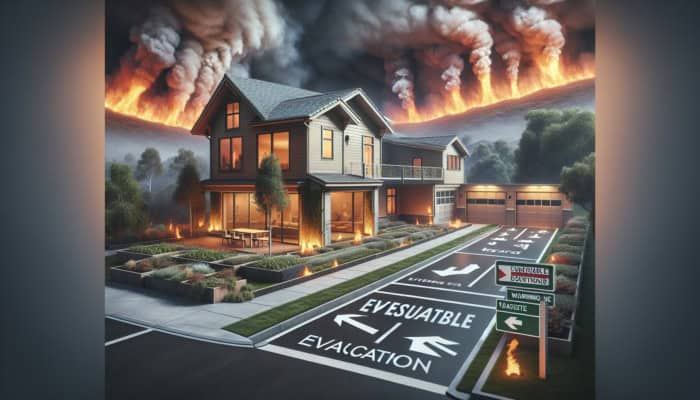Essential Wildfire Evacuation Guide: Mastering Emergency Preparedness for Your Safety
As the frequency of wildfires continues to rise, developing a comprehensive wildfire evacuation guide is crucial for ensuring your safety and readiness when emergencies strike. Recognizing the inherent dangers associated with wildfires and formulating an effective evacuation plan can significantly influence the outcome of these dire situations. This guide aims to empower you with essential knowledge and proactive strategies to navigate wildfire emergencies confidently and clearly.
Assessing Wildfire Risks: Evaluating Your Community’s Vulnerability

The first step in your wildfire preparedness journey should involve a thorough assessment of the wildfire risk present in your area. Some regions are inherently more susceptible to wildfires due to climatic conditions, types of vegetation, and their proximity to natural reserves. Accessing local fire risk maps and resources offered by fire departments or environmental agencies is vital. By understanding your property’s vulnerabilities, such as the surrounding vegetation types, the terrain, and historical fire occurrences, you can better equip yourself for potential threats.
Different communities exhibit varying levels of preparedness, and having a solid grasp of your local environment allows you to estimate how swiftly a fire could spread. For instance, areas dense with brush or trees pose a greater risk than those with open spaces. Additionally, familiarizing yourself with prevailing wind patterns can aid in predicting the behavior of an approaching wildfire. Local fire departments often conduct comprehensive assessments, providing valuable insights that can bolster your preparedness efforts.
Developing an Effective Evacuation Plan: Steps to Ensure Safe Exit Strategies
Creating a well-structured evacuation plan is essential during any crisis involving wildfires. Start by establishing clear and accessible evacuation routes for potential road closures due to fire activity or emergency services. It is wise to map out at least two distinct routes to ensure a quick exit, even if one becomes obstructed.
Involve all household members in the planning process, emphasizing the importance of adhering to the plan during emergencies. Regularly practice your evacuation route; this is particularly vital for children and elderly family members who may require additional assistance. Designate a meeting point outside the danger zone, ensuring everyone knows where to regroup if separated.
Lastly, make sure to keep your evacuation plan updated. Changes in family dynamics, new pets, or even newly identified hazards in your area could necessitate adjustments to your evacuation strategy. Regularly reviewing and rehearsing your plan will help ensure that everyone feels confident and prepared should the need to evacuate arise.
Assembling an Emergency Kit: Essential Items for Quick Departure
An emergency kit is an indispensable component of your wildfire evacuation guide. It should contain all necessary items for survival for at least 72 hours away from home. Begin with basic supplies such as water, non-perishable food, and a first-aid kit. Also, include personal hygiene items, flashlights, extra batteries, and any essential medications for your family members.
Consider your household’s unique needs: If there are infants, ensure that baby formula and diapers are included. Don’t forget to pack important documents such as identification, insurance papers, and medical records, ideally stored in a waterproof container for protection. It’s also prudent to have a spare set of clothes and sturdy shoes for each family member.
Finally, remember to include comfort items such as blankets and toys for children, as these can provide emotional support during stressful situations. Regularly check and refresh your emergency kit, ensuring that items are not expired, remain in good condition, and are ready for use.
Enhancing Your Home’s Safety for Wildfire Evacuation

Preparing your home for potential wildfire threats bolsters your safety and increases the likelihood that your property will survive a fire incident. Implementing protective measures can significantly mitigate damage and facilitate a smoother evacuation process.
Strengthening Your Home: Effective Measures to Protect Your Property
Fortifying your home against wildfires involves taking a series of proactive steps. Start by creating a defensible space around your property, which includes clearing away dead vegetation, trimming trees, and maintaining a safe distance between your home and any flammable materials. The recommended defensible space typically extends 30 feet around your residence, but it may be necessary to expand this distance further in high-risk areas.
Consider using fire-resistant materials for roofing and siding. Materials like metal roofing and stucco or brick exteriors can significantly enhance your home’s flame resistance. Furthermore, installing dual-pane windows can offer additional protection against heat and embers. Regular maintenance is crucial; ensure that gutters and roofs are kept clean to prevent the accumulation of debris that can ignite.
Lastly, guarantee that your property has adequate access for emergency services. Wide driveways and clear pathways can facilitate quicker responses from firefighting teams if they need to defend your home against encroaching flames.
Utility Management During Wildfire Evacuations: Safely Shutting Off Gas and Electricity
Managing utilities during a wildfire evacuation is crucial to prevent additional hazards. Before evacuating, ensure you know how to shut off your gas, electricity, and water safely. These actions can significantly reduce the risk of fires igniting on your property after you leave.
Please start with the gas lines; locate your gas meter and learn how to turn it off. If you are uncertain, consult your utility provider for guidance on safely executing this task. For electricity, switch off breakers to prevent power surges that could occur when the system is reactivated. This step is particularly important if you live in an area where electrical lines are at risk of falling.
Lastly, turning off your water supply can help prevent flooding if pipes burst in your absence. Make sure you are acquainted with the appropriate shut-off valves and that all family members understand how to execute these essential tasks efficiently.
Creating a Comprehensive Inventory: Documenting Your Belongings for Safety

Maintaining a detailed inventory of your belongings can be invaluable in a wildfire. Documenting your possessions not only aids in insurance claims but also facilitates recovery post-evacuation. Start by taking photographs or videos of each room in your home, ensuring you capture valuable items and their conditions in detail.
Store this documentation securely in an easily accessible location, such as a cloud storage service or a fireproof safe. Be sure to include receipts or appraisals for high-value items, as these documents can substantiate your claims during the recovery process.
Update your inventory regularly to reflect new purchases or changes in your household. This practice not only aids in recovery after a disaster but also encourages periodic assessments of your possessions’ value, which can be beneficial for insurance purposes.
Wildfire Evacuation Guide: Critical Actions During an Evacuation Alert
When an evacuation alert is issued, prompt and decisive action is essential. Knowing how to respond and maintaining clear communication can enhance safety during these critical moments.
Staying Updated: Utilizing Alerts and Monitoring Fire Progress
Staying informed is crucial for your safety and preparedness in times of crisis. Use local news outlets, social media platforms, and official government websites to monitor fire progression and evacuation orders. Many regions have established dedicated alert systems that send notifications via text or email, ensuring you receive timely updates regarding the situation.
Additionally, applications designed for emergency management can provide real-time information about wildfires, including maps that indicate current fire locations, ongoing containment efforts, and recommended evacuation routes. Make it a priority to download relevant applications and register for alerts when you recognize the potential for wildfire threats in your area.
Furthermore, a battery-operated radio can be a reliable backup for receiving information if power outages occur. Always plan to communicate with family members, ensuring everyone understands how to stay updated during a crisis.
Effective Communication Plans: Maintaining Contact with Family and Neighbors
Establishing a robust communication plan is essential during an evacuation scenario. Designate a primary point of contact for family members who may become separated during a crisis. Ensure that everyone can access each other’s phone numbers and understands how to reach you.
Group messaging applications can facilitate communication among family and friends, allowing for quick updates regarding your safety and whereabouts. Additionally, it can be beneficial to establish a predetermined meeting place outside the danger zone where you can regroup if cellular service is interrupted.
Engaging with your neighbors can cultivate community and support during emergencies. Share your plans with them, and consider forming a neighborhood group to keep each other informed and assist one another during an evacuation.
Identifying Evacuation Routes: Choosing the Safest Path Away from Danger
Knowing the safest routes is paramount when faced with an evacuation. Before an emergency arises, research and pinpoint multiple evacuation routes from your home. This planning is critical, as wildfires can spread rapidly, and main roads may become congested or blocked.
Consult local maps and engage with community resources to understand the most effective routes during a wildfire. Pay attention to any designated emergency routes recommended by local authorities. Familiarize yourself with these paths and make it a habit to drive them occasionally to ensure you can navigate them quickly under stress.
During an evacuation, avoid driving through smoke or flames. Stay calm, heed the instructions of local authorities, and follow their guidance regarding the safest routes to take. Be prepared for potential traffic congestion and allow ample time to reach safety.
Evacuating with Pets and Livestock: Special Considerations for Animal Safety
Evacuating with pets and livestock requires meticulous planning and preparation to ensure their safety and security during a wildfire. Integrating all animals into your evacuation strategy is essential to protect their well-being.
Assembling Pet Evacuation Kits: Essential Supplies for Your Furry Friends
Creating a pet evacuation kit is vital for safeguarding your animals during an emergency. Start with basic supplies: food, water, and bowls, as well as any medications your pets may require. Include important documents such as vaccination records and identification tags, and it is advisable to have a recent photograph of your pets to assist in locating them if they become lost.
In addition to supplies, ensure you have appropriate carriers or leashes for transport. Loading your pets into carriers in advance will streamline the process during an evacuation. If possible, include comforting items such as blankets or toys, which can help alleviate stress for your animals during chaotic situations.
Lastly, identify pet-friendly evacuation shelters in your area beforehand. Knowing where to take your pets will alleviate worries and make evacuation more efficient.
Planning for Livestock Evacuation: Transporting Larger Animals Safely
Due to their size and specific needs, evacuating livestock requires careful planning. Start by evaluating your transport options, ensuring you have a reliable trailer or vehicle capable of safely accommodating your animals.
Establish a comprehensive plan for transporting your livestock before an emergency arises, including routes and destination points. It’s crucial to have a safe and secure location where your animals can be housed during the evacuation. Collaborate with local farmers or agricultural organizations to identify potential shelters or boarding facilities that accommodate your livestock.
In addition to transport logistics, prepare a livestock emergency kit that includes feed, water, and necessary veterinary supplies. Familiarize your animals with the trailer or transport vehicle to minimize stress during the evacuation process.
Identifying Sheltering Options: Safe Havens for Pets and Livestock
Finding suitable shelter for pets and livestock is crucial during a wildfire evacuation. Numerous resources, including local animal control agencies, shelters, and community groups, can assist with locating safe havens.
Before an emergency arises, research local animal shelters that accommodate pets during evacuations. Many communities have established partnerships with shelters to ensure animals are cared for during times of crisis. Also, consult local veterinary clinics, which may offer boarding services during emergencies.
For livestock, contact local agricultural organizations or extension services. They can provide guidance on available facilities and resources designed for housing larger animals during evacuations.
Wildfire Evacuation Guide: Important Steps for Post-Evacuation Procedures
Once the immediate threat has passed, it is essential to approach the post-evacuation period with caution and mindfulness. Understanding the proper actions upon returning home can help ensure your safety and facilitate recovery efforts.
Returning Home Safely: Guidelines for Re-Entry to Your Property
Returning home after an evacuation necessitates vigilance and caution. Always wait for official notifications indicating it is safe to return to your property. Authorities will conduct assessments to determine when conditions are suitable for re-entry.
Once you receive clearance, approach your home with care. Be alert to hazards such as downed power lines, unstable structures, or smoldering debris. If you encounter any active flames or smoke, evacuate immediately and notify local authorities.
When re-entering your home, wear protective clothing, including sturdy shoes and a mask, to shield yourself from dust and debris. Before unpacking or resuming normal activities, conduct a thorough inspection of your property for any damage or hazards.
Evaluating Damage: Essential Steps for Documenting Property Conditions
After returning home, assessing damage is crucial for recovery. Begin by documenting all visible damage and taking photographs or videos of affected areas. This documentation will be vital for insurance claims and recovery efforts.
Look for structural damage, such as cracks in walls, roof damage, or compromised foundations. Check for potential water damage, electrical hazards, and gas leaks. If you suspect significant damage, it may be prudent to consult professionals before attempting repairs.
Also, maintain a detailed record of expenses incurred during your evacuation and recovery process. This information will be invaluable when navigating insurance claims and seeking assistance.
Navigating Insurance Claims: Key Steps After Wildfire Damage
Navigating the insurance claims process following a wildfire can be overwhelming, but being prepared can simplify the experience. Start by contacting your insurance provider as soon as possible to report the damage and initiate the claims process.
Provide your insurer with the documentation you gathered while assessing the damage, including photographs and details of your possessions. Be clear about your coverage and any specific policies related to wildfire damage, as these can vary significantly among providers.
Keep detailed records of all communications with your insurance company, including dates, names, and content of conversations. This diligence will help ensure your claim is processed efficiently and will be a reference if disputes arise.
Community and Government Resources for Effective Wildfire Evacuation
Accessing community and government resources can significantly enhance your preparedness and response during a wildfire. Understanding the support available can make a considerable difference in navigating these crises.
Engaging with Local Emergency Services: Accessing Help and Information
Local emergency services play an essential role in wildfire response and recovery efforts. Familiarize yourself with the contact information for your local fire department, police, and emergency management offices. Many municipalities provide resources and alerts to inform residents about wildfire risks and safety procedures.
Attend community meetings or workshops hosted by local agencies to enhance your understanding of wildfire prevention and preparedness. These events often offer valuable insights and allow residents to ask specific questions regarding their concerns.
In addition to traditional emergency services, local non-profit organizations may provide crucial support during crises, offering resources for shelter, food, and medical assistance. Ensure you have their contact information readily available during an emergency.
Exploring Government Assistance Programs: Financial and Housing Support Options
Government assistance programs can provide vital financial support for recovery efforts in the aftermath of a wildfire. Familiarize yourself with local, state, and federal resources available for disaster relief, including the Federal Emergency Management Agency (FEMA) and local housing authorities.
Many programs offer grants or low-interest loans to assist with home repairs, temporary housing, and other recovery-related expenses. Be proactive in applying for assistance as soon as you are eligible, as many programs operate on a first-come, first-served basis.
Additionally, community organizations often collaborate with government agencies to provide resources and assistance. Contact local non-profits for information on available support services.
Building Community Networks: Strengthening Resilience Through Local Collaboration
Engaging with community networks can enhance resilience to wildfires. Local groups, such as neighborhood associations or fire safety councils, can provide valuable support and resources during emergencies.
Participate in community preparedness initiatives, such as fire drills or educational programs, to strengthen your knowledge and skills. Building relationships with neighbors fosters a sense of solidarity, allowing you to support one another during crises.
Consider volunteering with local organizations focused on wildfire prevention and recovery. This involvement enhances your understanding of fire safety and contributes to building a stronger, more resilient community.
Long-Term Strategies for Wildfire Prevention and Preparedness
Implementing long-term strategies is essential for wildfire prevention and preparedness. Taking proactive measures can help mitigate the risk of wildfires affecting your home and community.
Landscaping for Fire Safety: Establishing Defensible Space Around Your Property
Creating defensible space around your property is a critical component of wildfire prevention. This involves landscaping practices designed to reduce the flammability of the vegetation surrounding your home.
Start by trimming trees and shrubs, ensuring a safe distance between them and your house. Remove any dead or dry vegetation and create firebreaks by utilizing gravel or dirt paths to slow the spread of fire.
Incorporate fire-resistant plants, such as succulents or other moisture-rich flora, into your landscaping. These plants are less likely to ignite. Regular maintenance, such as mowing lawns and clearing debris, will enhance your property’s fire safety.
Participating in Community Firewise Programs: Collaborating for Local Safety Initiatives
Many communities engage in Firewise programs that promote wildfire safety and preparedness. Actively participating in these initiatives can provide invaluable resources and support for both individual homeowners and the community as a whole.
Join community events focused on education and awareness, such as workshops, training sessions, and clean-up efforts. These activities can foster collaboration among residents and local agencies, enhancing overall fire resilience.
Consider advocating for or participating in local Firewise committees. These committees work to identify risks and implement strategies to mitigate wildfire threats. This involvement benefits your property and contributes to the safety and preparedness of your entire community.
Commitment to Education and Training: Staying Informed and Prepared for Wildfires
Ongoing education and training are vital for long-term wildfire preparedness. Stay informed about wildfire risks in your area, including seasonal patterns and potential fire behavior.
Consider enrolling in emergency preparedness, first aid, and wildfire response courses. Many local fire departments and community organizations offer training sessions to empower you and your family with the knowledge to respond effectively in emergencies.
Stay engaged with local resources, such as newsletters and social media channels, to receive updates on wildfire safety practices and community initiatives. The more informed you and your community members are, the better prepared you will be for potential wildfire threats.
Understanding the Psychological Impact of Wildfire Evacuation and Coping Strategies
The psychological ramifications of wildfires and the evacuation process can be profound, affecting emotional well-being long after the event has passed. Recognizing this aspect of disaster recovery is essential for supporting individuals and communities.
Recognizing Trauma: The Emotional Effects of Evacuation
Experiencing a wildfire evacuation can lead to significant emotional distress and trauma. Individuals may encounter feelings of anxiety, fear, and uncertainty during and after the crisis. Understanding these emotions is the first step toward recovery.
Recognize that it is normexpectedexperience a range of emotions following such events. Trauma can manifest in various ways, including nightmares, difficulty concentrating, and heightened stress responses. Being aware of these symptoms can help individuals seek appropriate support.
Engaging with mental health professionals can provide valuable coping strategies and support. Community resources may offer counseling services tailored to individuals affected by wildfires, helping foster recovery and resilience.
Effective Coping Mechanisms: Techniques for Managing Stress and Anxiety
Developing effective coping mechanisms is essential for managing stress and anxiety during and after a wildfire evacuation. Mindfulness and relaxation techniques, such as deep breathing exercises or meditation, can help alleviate emotional distress.
Establishing a routine can provide a sense of normalcy and stability even amid chaos. Engaging in physical activities, such as walking, yoga, or other forms of exercise, can also help lower stress levels.
Connecting with friends and loved ones to share experiences and feelings is vital. Social support plays a crucial role in emotional healing, and discussing your experiences with others who have faced similar challenges can foster a sense of community and understanding.
Accessing Support Systems: Finding Help and Counseling Services
Accessing support systems is crucial for emotional recovery after a wildfire evacuation. Reach out to community organizations, mental health professionals, or local hotlines that provide counseling services for disaster victims.
Many local agencies offer support groups specifically for individuals who have experienced wildfires. These groups create safe spaces for sharing experiences and coping strategies, fostering resilience among participants.
Additionally, online resources and forums can provide valuable information and support for managing the psychological impact of wildfires. Engaging with these resources can empower individuals to seek help and navigate their recovery journey.
Learning from Wildfire Evacuation Case Studies: Real-Life Examples
Examining past wildfire incidents can provide valuable insights and lessons for future preparedness and response. By learning from real-life examples, communities can enhance their resilience and improve evacuation strategies.
Successful Evacuations: Insights from Past Incidents
Several case studies highlight the importance of preparedness and effective evacuation strategies during wildfires. One notable example is the 2018 Camp Fire in California, where rapid evacuation orders saved countless lives. The significance of timely notifications and clear communication channels became evident, leading to improved systems in subsequent incidents.
Communities that had established and rehearsed evacuation plans were able to respond more effectively, ensuring that residents understood where to go and how to stay safe. These experiences led to the widespread adoption of community drills and enhanced public awareness campaigns focused on wildfire preparedness.
Diverse Community Responses: How Various Areas Have Managed Wildfires
Different regions have developed various strategies for managing wildfires, showcasing the importance of local adaptation. For instance, some communities have implemented stringent building codes and landscaping regulations to mitigate fire risks, while others emphasize community engagement and education.
The success of these strategies often hinges on collaboration between local agencies, residents, and non-profit organizations. By learning from one another and sharing best practices, communities can develop more effective responses to wildfire threats.
Technological Innovations: Utilizing Apps and Tools for Enhanced Preparedness
Advancements in technology have significantly improved wildfire preparedness and response efforts. Numerous applications now provide real-time information about wildfire incidents, evacuation routes, and safety tips.
For example, apps that integrate satellite imagery and weather data allow users to monitor fire behavior and make informed decisions about evacuation. These technological tools empower individuals to stay informed and respond swiftly during emergencies.
Additionally, communities increasingly leverage social media platforms to disseminate information quickly and efficiently during wildfire incidents. This connectivity can facilitate timely updates and foster community during crises.
Frequently Asked Questions (FAQs)
What is the first step if I receive an evacuation alert?
If you receive an evacuation alert, remain calm and adhere to your pre-established evacuation plan. Gather your emergency kit, secure your home, and evacuate as soon as it is safe.
How can I evaluate my wildfire risk level?
Assess your wildfire risk by researching local fire history, examining vegetation types, and consulting resources provided by your fire department. Understanding your area’s vulnerabilities is crucial for effective preparedness.
What essentials should I include in my pet evacuation kit?
Your pet evacuation kit should contain food, water, bowls, medications, identification, and a recent photo of your pet. Additionally, ensure you have leashes and carriers for safe transport.
What steps can I take to fortify my home against wildfires?
To fortify your home, create a defensible space by removing flammable vegetation, utilizing fire-resistant materials, and maintaining your property. Regular maintenance is also essential for long-term protection.
What actions should I take when returning home after an evacuation?
When returning home, wait for official clearance, then inspect your property for damage. Document any issues thoroughly and ensure utilities are safe to restore before re-entering your home.
What types of government assistance are available following a wildfire?
Government assistance may include grants and loans for home repairs and temporary housing. Check with FEMA and local agencies for specific programs available in your area.
How can I prepare my community for potential wildfires?
Engage in community preparedness initiatives, participate in educational programs, and collaborate with local agencies to promote fire safety and resilience within your neighborhood.
What are effective coping strategies for dealing with wildfire trauma?
Coping strategies include practicing mindfulness, establishing routines, and seeking social support. If you experience prolonged emotional distress, consider professional counseling.
How can I stay informed during a wildfire evacuation?
Stay informed by utilizing local news sources, social media, and emergency alert systems. Download relevant apps for real-time updates on fire progression and recommended evacuation routes.
What should I do if I suspect structural damage after a wildfire?
If you suspect structural damage, thoroughly document it and consult professionals before repairing it. Prioritize safety when assessing your property.
Explore our latest updates on X!
Post-Disaster Bartering: Essential Strategies
Exploring the Concept of Post-Disaster Bartering What Is the Concept of Post-Disaster Bartering? Post-Disaster Bartering: Post-disaster bartering refers to the exchange of goods and services that occurs when conventional currency systems collapse due to catastrophic events, such as natural disasters, economic crises, or societal upheavals. During these critical moments, individuals and communities utilise the resources […]
Hurricane Generator Use: Powering Through Storms
Maximising the Benefits of Hurricane Generator Usage What Exactly Are Hurricane Generators? Hurricane Generator Use: Hurricane generators are advanced power supply devices specifically engineered to deliver electricity during extreme weather events, particularly during hurricanes, when standard power infrastructures may fail. These robust machines ensure that both residential and commercial establishments receive the power they need, […]
Emergency Family Plan: Universal Preparation Guide
Comprehensive Elements to Include in Your Family Emergency Plan Effective Communication Strategies for Emergencies Emergency Family Plan: Establishing effective communication strategies is absolutely vital for ensuring that family members remain connected and informed during emergencies. It’s crucial to have clear, reliable methods in place that everyone understands and can utilise effortlessly. This encompasses traditional communication […]
Survival Water Bottles: Essential Gear for Emergencies
Why Survival Water Bottles are Essential for Emergency Preparedness Understanding the Significance of Hydration in Crisis Situations Survival Water Bottles: Maintaining hydration is vital for ensuring optimal bodily functions during emergencies. In scenarios where access to clean water is limited, sustaining proper hydration is crucial in preventing health complications associated with dehydration, which can include […]








Your post really resonates with me, especially as someone who lives in a wildfire-prone area. I remember a few years back, when a fire broke out nearby, and it was absolute chaos trying to figure out what to do in such a limited time frame. The panic of grabbing important documents and essentials while trying to keep track of loved ones was overwhelming.
It sounds like that experience was incredibly intense. It’s one thing to plan for emergencies, but nothing really prepares you for the chaos when it happens. The moments when you have to decide what truly matters—documents, sentimental items, pets—can feel surreal.
I completely understand how overwhelming that must have been. To help others navigate such situations more effectively, I’ve put together some resources that might be useful for anyone living in wildfire-prone areas. Check them out here!
https://survivalbite.com/wild
This is such an important topic, especially considering how rapidly wildfire seasons seem to escalate each year. It’s good to see an emphasis on assessing community risks because often, people don’t realize just how vulnerable their area might be until it’s too late. I remember going through a similar process when we moved to a more fire-prone area; checking local fire maps and connecting with neighbors who had experienced evacuations helped us feel more prepared.
It’s great to hear about your proactive approach to understanding the risks in your fire-prone area. It’s not just about the maps or statistics; building relationships with neighbors who have firsthand experience can really change the game. Those conversations can uncover local knowledge that isn’t always in the brochures—like specific challenges or strategies that worked (or didn’t work) for them during an evacuation.
“Absolutely, awareness is key! If you’re looking to further enhance your preparedness, check out this resource that offers valuable tools and insights for assessing community fire risks.”
https://survivalbite.com/LostFoods
I really appreciate this guide; it’s such a timely reminder of how crucial it is to be proactive about wildfire preparedness. Living in an area that’s prone to wildfires has opened my eyes to just how unprepared I was in the past. I remember one summer when fires got dangerously close, and I realized I had no evacuation plan in place. It’s incredible how quickly things can escalate.
Your emphasis on assessing wildfire risks is a critical point that often gets overlooked in discussions about evacuation preparedness. From my experience living in an area that’s faced multiple fire threats, I’ve learned that awareness of one’s environment is just as important as having a concrete evacuation plan.
Your insights on wildfire preparedness resonate deeply, especially given the increasing unpredictability of such events. I remember when my community faced a significant wildfire threat last summer; it really highlighted the importance of understanding our local risks and having a solid plan in place. The local fire department’s resources were invaluable—it’s fascinating how community engagement can truly make a difference in these situations.
This guide is such a timely and valuable resource! Living in an area that frequently faces wildfire threats, I’ve realized how vital it is to stay informed and prepared. We recently worked on creating a family evacuation plan, and it made me understand the importance of knowing not just our escape routes, but also the local resources like community centers that offer shelter.
It’s great to hear about your proactive approach to creating a family evacuation plan. Knowing your escape routes and local resources can make a significant difference in a stressful situation. Have you also considered including communication strategies in your plan? Establishing contact points or check-in procedures can help ensure everyone stays connected during an emergency. Additionally, regularly reviewing and practicing your plan can keep it fresh in everyone’s minds. It’s all about combining preparedness with clear communication, especially in challenging circumstances like wildfires.
I’m glad to hear that you found the guide helpful! To further enhance your preparedness, check out this resource for more tips on evacuation plans and local shelters.
https://survivalbite.com/wild
This guide provides a crucial framework for individuals and families to proactively prepare for wildfires, which is increasingly relevant as we witness shifts in climate patterns and their resultant impact on fire seasons. I live in an area that’s considered at risk for wildfires, and I can attest to the importance of being prepared.
This is such a timely and essential topic, especially as wildfire seasons grow longer and more intense. I appreciate how you’ve emphasized the importance of assessing our community’s wildfire risks. It’s eye-opening to think about how many factors, from vegetation types to climate, play a role in our local vulnerability.
It really is striking how interconnected everything is when it comes to wildfire risks. The way you pointed out the different factors, like vegetation types and climate, really hits home. I live in a region that’s seen its share of wildfires, and every season brings that anxious anticipation of what might come. It’s fascinating to see how communities are starting to take action—like creating defensible space and investing in fire-resilient landscaping.
It’s great to hear your perspective on the importance of understanding our community’s wildfire risks. The complexities of wildfires, especially with the changing climate, indeed warrant a closer look. It’s striking to consider how many interconnected elements contribute to our vulnerability.
Thank you for your thoughtful comment! To delve deeper into understanding and mitigating wildfire risks in your area, check out this valuable resource.
https://survivalbite.com/wild
This guide highlights a crucial aspect of community safety that often gets overlooked in discussions about emergency preparedness. Having lived in a fire-prone area, I can attest to the importance of knowing your local risks, but what’s equally vital is understanding your resources. For instance, while fire risk maps are incredibly helpful, pairing them with real-time alerts from local fire departments can keep residents informed during critical situations.
You raise some really important points about community safety that resonate with many of us who live in areas prone to various risks. It’s easy to focus on preparing for emergencies without considering how to stay informed during those times. You’ve hit the nail on the head—knowing how to access and utilize the resources available can make a significant difference when disaster strikes.
“Absolutely, staying informed is key! For those looking to enhance their awareness and preparedness, check out these real-time alert tools that can keep you in the loop during emergencies.”
https://survivalbite.com/wild
It’s really interesting to see a focus on wildfire preparedness, especially since so many communities are feeling the impacts of these emergencies more frequently. I live in an area where wildfires are a constant threat, and I know firsthand how important it is to have a solid evacuation plan. Last year, during a particularly tense season, my family and I had to make quick decisions about how to prioritize what to take and where to go. It’s amazing how fast chaos can set in.